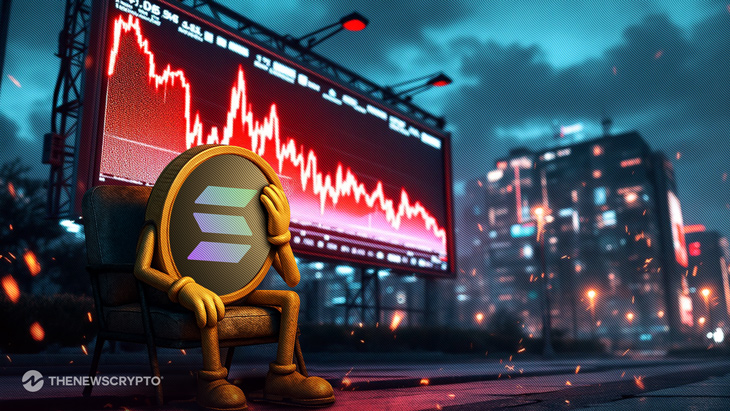PumpSwap captures 74% of Solana DEX volume as memecoins surge

Solana’s DEX ecosystem has had a very active month, fueled by a spike in new token listings, surging volume, and PumpSwap’s growing grip over trading flows. While SOL retreated to just below $180 after peaking above $205, the spike in activity across DEXs suggests that the retail-driven memecoin wave primarily powered the turnover. However, the mechanics seem different than earlier in the year after a deeper look.
Data from Dune shows clear divergences between where tokens launch and where liquidity concentrates. Raydium’s LaunchLab remains the preferred venue for pair creation, but PumpSwap now processes over 70% of Solana’s daily DEX volume. This is driven by PumpSwap’s memecoin-focused listing policies and frictionless market structure. The result is a fragmented but very active DEX market.
On July 21, approximately 241,356 new trading pairs were created across Solana DEXs. Raydium LaunchLab was responsible for 157,195 of the pairs (65%), followed by Pump.fun with 49,899 and PumpSwap with 26,689.

Even though almost all of these tokens are short-lived and illiquid, their sheer volume reflects a market driven by speed. The correlation between new listings and SOL’s price is also clear. The week of July 21 marked the top for SOL at $205.81, up 40% from July 1’s $146.90. As token creation normalized in the following days, SOL declined nearly 11% to $183.13 by July 28.
This behavior is another clear example of the speculative churn that became the foundation of Solana’s DeFi market: rapid token launches spark immediate trading demand, pushing up volumes and, temporarily, SOL.
One of the biggest changes we’ve seen this month is in market share. As of July 28, PumpSwap handled 73.6% of all Solana DEX volume, processing $16.8 billion of the $22.8 billion total. Raydium followed with $2.9 billion (12.6%), Orca with $1.5 billion (6.6%), and Meteora with $1.0 billion (4.5%).

PumpSwap’s dominance isn’t coincidental. It has emerged as the go-to venue for memecoin traders due to its frictionless listing model, minimal vetting, and gamified interfaces. Its support for ultra-low market cap tokens and aggressive liquidity incentives has made it the epicenter of Solana’s short-cycle, high-risk trading.
The difference in trading behavior is stark. While Raydium’s LaunchLab remains the most popular entry point for new tokens, traders quickly migrate to PumpSwap for actual execution. This explains why Raydium saw 157,000 new pairs created on July 21 but only captured 12.6% of volume on July 28. PumpSwap, by contrast, had just 26,689 new pairs launched but handled over 70% of all flow.
Despite being eclipsed by PumpSwap in current market share, Raydium remains the all-time volume leader across Solana DEXs. Its lifetime volume has surpassed $1.06 trillion, far ahead of PumpSwap’s $483.9 billion, Orca’s $471.87 billion, and Meteora’s $241.41 billion.

However, the trajectory suggests PumpSwap could close that gap. Over the past 30 days, PumpSwap recorded $251.41 billion in volume, compared to Raydium’s $34.96 billion and Meteora’s $26.47 billion. In just one day (July 28), PumpSwap facilitated $8.16 billion, more than six times Raydium’s $1.23 billion and over 14 times Orca’s $581.49 million.
The data also highlights a concentration of short-term liquidity. PumpSwap’s 1-day to 30-day volume ratio (3.2%) is similar to Raydium’s (3.5%), but its absolute size is substantially higher. This suggests a much higher velocity of capital and a preference among traders to use PumpSwap for both entries and exits.
While SOL’s price has retreated 11% from its July 22 high, Solana DEX volumes have remained elevated. The 30-day volume total across the top projects stands at $368 billion, led by PumpSwap. Even as SOL fell to $183.13 by July 28, PumpSwap maintained $8.16 billion in daily volume, up from $6.45 billion at the start of the month.
This indicates ongoing churn in secondary markets, particularly around memecoins and microcaps. While the launch intensity may have slowed after July 21, speculative appetite among traders has not. This decoupling between asset price and platform activity suggests that Solana’s DEX ecosystem is maturing into a full-fledged high-frequency environment, where token price discovery continues regardless of broader market conditions.
Projects like Orca and Meteora continue to hold niche positions in the Solana DEX landscape. Orca processed $5.11 billion in the past week and $18.35 billion over the past 30 days, while Meteora handled $3.43 billion and $26.47 billion, respectively.
Interestingly, both protocols show lower daily shares than their 30-day average, indicating steadier flows and fewer spikes. This implies that while PumpSwap captures speculative peaks, platforms like Orca and Meteora may serve as liquidity hubs for more predictable order flow, such as LP arbitrage or large-scale transactions.
The post PumpSwap captures 74% of Solana DEX volume as memecoins surge appeared first on CryptoSlate.
PumpSwap captures 74% of Solana DEX volume as memecoins surge

Solana’s DEX ecosystem has had a very active month, fueled by a spike in new token listings, surging volume, and PumpSwap’s growing grip over trading flows. While SOL retreated to just below $180 after peaking above $205, the spike in activity across DEXs suggests that the retail-driven memecoin wave primarily powered the turnover. However, the mechanics seem different than earlier in the year after a deeper look.
Data from Dune shows clear divergences between where tokens launch and where liquidity concentrates. Raydium’s LaunchLab remains the preferred venue for pair creation, but PumpSwap now processes over 70% of Solana’s daily DEX volume. This is driven by PumpSwap’s memecoin-focused listing policies and frictionless market structure. The result is a fragmented but very active DEX market.
On July 21, approximately 241,356 new trading pairs were created across Solana DEXs. Raydium LaunchLab was responsible for 157,195 of the pairs (65%), followed by Pump.fun with 49,899 and PumpSwap with 26,689.

Even though almost all of these tokens are short-lived and illiquid, their sheer volume reflects a market driven by speed. The correlation between new listings and SOL’s price is also clear. The week of July 21 marked the top for SOL at $205.81, up 40% from July 1’s $146.90. As token creation normalized in the following days, SOL declined nearly 11% to $183.13 by July 28.
This behavior is another clear example of the speculative churn that became the foundation of Solana’s DeFi market: rapid token launches spark immediate trading demand, pushing up volumes and, temporarily, SOL.
One of the biggest changes we’ve seen this month is in market share. As of July 28, PumpSwap handled 73.6% of all Solana DEX volume, processing $16.8 billion of the $22.8 billion total. Raydium followed with $2.9 billion (12.6%), Orca with $1.5 billion (6.6%), and Meteora with $1.0 billion (4.5%).

PumpSwap’s dominance isn’t coincidental. It has emerged as the go-to venue for memecoin traders due to its frictionless listing model, minimal vetting, and gamified interfaces. Its support for ultra-low market cap tokens and aggressive liquidity incentives has made it the epicenter of Solana’s short-cycle, high-risk trading.
The difference in trading behavior is stark. While Raydium’s LaunchLab remains the most popular entry point for new tokens, traders quickly migrate to PumpSwap for actual execution. This explains why Raydium saw 157,000 new pairs created on July 21 but only captured 12.6% of volume on July 28. PumpSwap, by contrast, had just 26,689 new pairs launched but handled over 70% of all flow.
Despite being eclipsed by PumpSwap in current market share, Raydium remains the all-time volume leader across Solana DEXs. Its lifetime volume has surpassed $1.06 trillion, far ahead of PumpSwap’s $483.9 billion, Orca’s $471.87 billion, and Meteora’s $241.41 billion.

However, the trajectory suggests PumpSwap could close that gap. Over the past 30 days, PumpSwap recorded $251.41 billion in volume, compared to Raydium’s $34.96 billion and Meteora’s $26.47 billion. In just one day (July 28), PumpSwap facilitated $8.16 billion, more than six times Raydium’s $1.23 billion and over 14 times Orca’s $581.49 million.
The data also highlights a concentration of short-term liquidity. PumpSwap’s 1-day to 30-day volume ratio (3.2%) is similar to Raydium’s (3.5%), but its absolute size is substantially higher. This suggests a much higher velocity of capital and a preference among traders to use PumpSwap for both entries and exits.
While SOL’s price has retreated 11% from its July 22 high, Solana DEX volumes have remained elevated. The 30-day volume total across the top projects stands at $368 billion, led by PumpSwap. Even as SOL fell to $183.13 by July 28, PumpSwap maintained $8.16 billion in daily volume, up from $6.45 billion at the start of the month.
This indicates ongoing churn in secondary markets, particularly around memecoins and microcaps. While the launch intensity may have slowed after July 21, speculative appetite among traders has not. This decoupling between asset price and platform activity suggests that Solana’s DEX ecosystem is maturing into a full-fledged high-frequency environment, where token price discovery continues regardless of broader market conditions.
Projects like Orca and Meteora continue to hold niche positions in the Solana DEX landscape. Orca processed $5.11 billion in the past week and $18.35 billion over the past 30 days, while Meteora handled $3.43 billion and $26.47 billion, respectively.
Interestingly, both protocols show lower daily shares than their 30-day average, indicating steadier flows and fewer spikes. This implies that while PumpSwap captures speculative peaks, platforms like Orca and Meteora may serve as liquidity hubs for more predictable order flow, such as LP arbitrage or large-scale transactions.
The post PumpSwap captures 74% of Solana DEX volume as memecoins surge appeared first on CryptoSlate.

